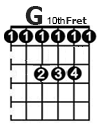

More commonly known as the Gsus2/Fsharp – I use this as my G/F#

Untidy Music Guitar Lessons


More commonly known as the Gsus2/Fsharp – I use this as my G/F#


The B minor Barre is 2nd fret.
This means that your 1st finger should be flat across all the strings at the 2nd fret whilst your thumb should be around halfway down the back of the neck of the guitar.
This will allow you to fret the 2nd, 3rd and 4th fingers and increase your ability to bridge the strings.
Alternatives:





.jpg?resize=400%2C600&ssl=1)
The A Major Barre is the ‘F’ Shape played on the 5th fret.
This means that your 1st finger should be flat across all the strings at the 5th fret whilst your thumb should be around halfway down the back of the neck of the guitar.
This will allow you to fret the 2nd, 3rd and 4th fingers and increase your ability to bridge the strings.












Version 2: If you have a chord progression that goes from C Major to Cadd9 the chord below will more than likely be the chord you will be using – the first finger can stay in position.







G Major Barre Chord
.jpg?resize=400%2C600&ssl=1)

This alternative G Major Barre is the ‘B’ Shape played on the 10th fret.
This means that your 1st finger should be flat across all the strings at the 10th fret whilst your thumb should be around halfway down the back of the neck of the guitar.
This will allow you to fret the 2nd, 3rd and 4th fingers and increase your ability to bridge the strings.
Alternatively you could bridge your 3rd finger across the D, G and B strings rather that fret them with your 2nd, 3rd and 4th fingers.